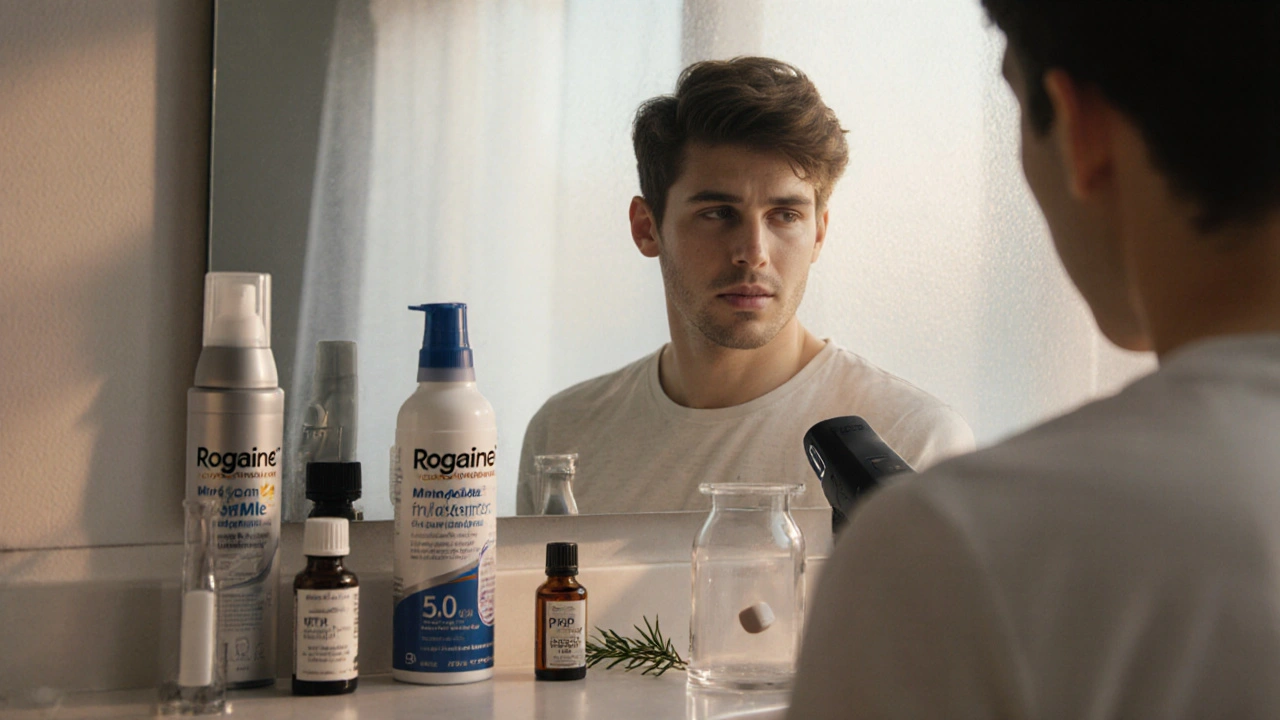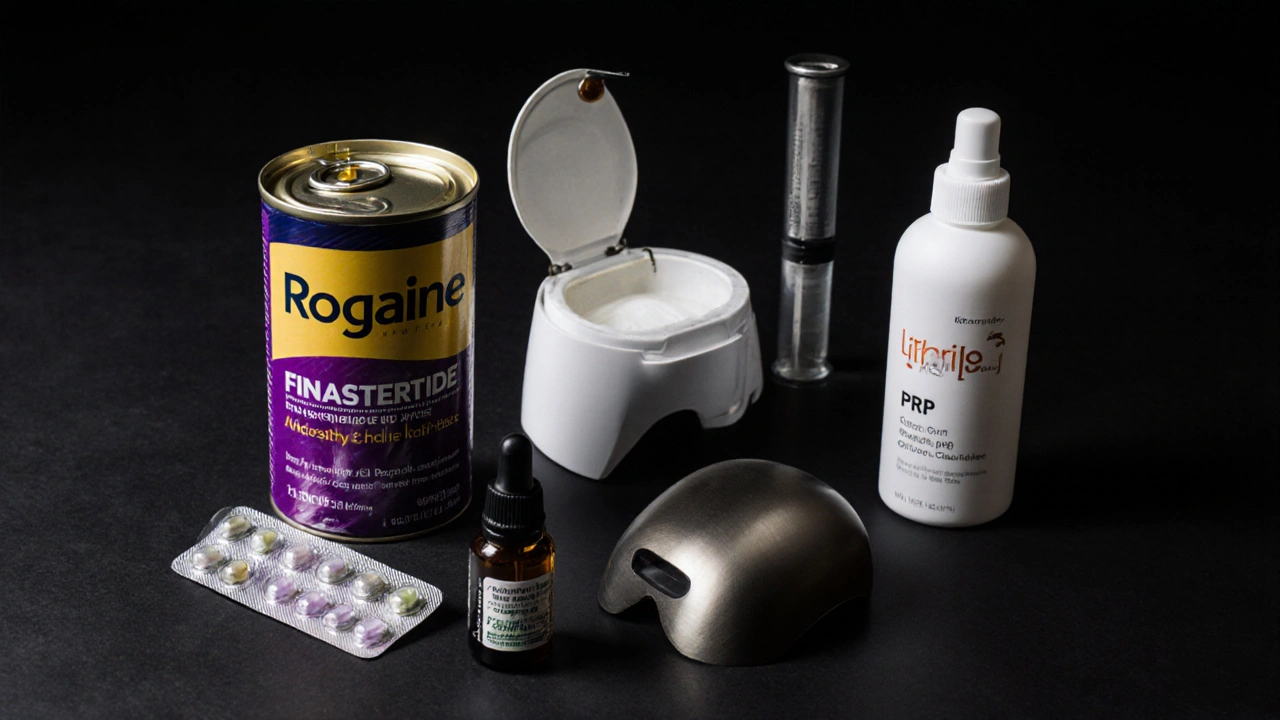
Hair Loss Treatment Comparison Tool
Select Your Situation
Choose your hair loss scenario to get personalized recommendations.
Recommended Treatment Based on Your Profile
Detailed Comparison
Deciding how to tackle hair thinning can feel like wandering through a maze of creams, pills, lasers and pricey clinics. You’ve probably heard the name Rogaine 5% Minoxidil everywhere, but you’re not sure if it truly beats the other options on the market. This guide lines up the most popular alternatives side‑by‑side, breaks down the science, and gives you a clear way to pick the right solution for your own scalp.
What makes Rogaine 5% Minoxidil tick?
Rogaine is a topical solution that delivers 5% minoxidil, an FDA‑approved vasodilator that stimulates hair follicles. First approved for men in 1988 and later for women, Rogaine’s active component, Minoxidil, was originally an oral blood‑pressure drug. When applied to the scalp, it widens blood vessels, improves nutrient flow, and prolongs the growth phase (anagen) of hair.
Key attributes of Rogaine 5%:
- Twice‑daily liquid or foam application
- Visible regrowth in 3‑6 months for many users
- Typical cost:AU$30‑40 per month for a 60ml bottle
- Common side effects: scalp irritation, itching, rare dizziness
Because it’s a topical, you can stop using it at any time, but regrowth will usually fade within a few months after discontinuation.
Popular alternatives at a glance
Below are the main contenders people compare against Rogaine, grouped by how they work.
- Finasteride - an oral 1mg prescription pill that blocks DHT formation.
- Platelet‑Rich Plasma (PRP) therapy - injections of your own concentrated platelets into the scalp.
- Low‑Level Laser Therapy (LLLT) - devices like helmets or combs emitting red light to stimulate follicles.
- Hair transplant surgery - moving healthy grafts from a donor area to thinning zones.
- Rosemary oil - a natural essential oil with some evidence of mild regrowth.
- Ketoconazole shampoo - antifungal wash that also reduces scalp inflammation.
Side‑by‑side comparison
| Attribute | Rogaine 5% Minoxidil | Finasteride (1mg) | PRP Therapy | LLLT Devices | Hair Transplant | Rosemary Oil |
|---|---|---|---|---|---|---|
| Active ingredient | Minoxidil | Finasteride | Platelet‑rich plasma | Red‑light photons (630‑660nm) | Autologous hair follicles | Rosmarinus officinalis extract |
| Delivery method | Topical foam/liquid | Oral tablet | Scalp injections | Helmet, comb or cap | Surgical graft placement | Scalp massage |
| Typical cost (AU$) | 30‑40 / month | 20‑30 / month | 600‑1,200 per session (3‑4 sessions) | 200‑500 (device purchase) | 5,000‑12,000 (one‑time) | 15‑25 per 30ml bottle |
| FDA status | Approved (OTC) | Approved (prescription) | Off‑label, experimental | Cleared (medical device) | Not FDA‑regulated (surgical) | Not regulated as drug |
| Clinical effectiveness | 30‑45% show visible regrowth | 70‑80% maintain existing hair, 30‑40% see new growth | ~25% report moderate improvement | ~40% report thicker hair | 95‑98% permanent density increase | ~10‑15% minor thickening |
| Common side effects | Scalp irritation, itching | Sexual dysfunction, mood changes | Bruising, mild pain | Eye strain (if mis‑used) | Scarring, infection risk | Allergic rash (rare) |
| Maintenance requirement | Ongoing use needed | Daily pill | Every 3‑6months | 3‑5times/week | None after grafts heal | Daily application |

Best‑for scenarios
Not every scalp story fits a single solution. Below are typical user profiles and the option that usually works best.
- Early‑stage thinning (Norwood II‑III) - Rogaine 5% Minoxidil or LLLT are cost‑effective ways to stimulate existing follicles.
- Pattern baldness driven by DHT - Finasteride tackles the hormone root cause and often pairs well with minoxidil for a two‑pronged attack.
- Desire for natural, low‑cost care - Rosemary oil mixed with a carrier oil can be a gentle add‑on, though expectations should stay modest.
- Extensive loss and willingness to invest - Hair transplant delivers permanent density and is the gold standard when donor hair is sufficient.
- Seeking a clinic‑based boost without surgery - PRP offers a middle ground; results vary, but many appreciate the autologous nature.
Pros and cons of each option
Understanding the trade‑offs helps you avoid surprises.
| Option | Pros | Cons |
|---|---|---|
| Rogaine 5% Minoxidil | OTC, easy to use, clinically proven for many users, reversible | Needs lifelong commitment, scalp irritation possible, modest results for severe loss |
| Finasteride | Targets DHT, works well for men, can preserve existing hair | Prescription only, sexual side effects, not suitable for women of child‑bearing age |
| PRP Therapy | Uses own blood, minimal allergic risk, can improve texture | Expensive, requires multiple clinic visits, variable efficacy |
| LLLT Devices | Non‑invasive, can be used at home, no medication needed | High upfront cost, effectiveness modest, requires consistent use |
| Hair Transplant | Permanent, high density, natural look | Very pricey, surgical risks, donor area limits |
| Rosemary Oil | Cheap, natural, easy to integrate into routine | Scientific support limited, outcomes subtle, may cause irritation if undiluted |
How to decide which path to take
Follow this quick decision tree:
- Assess severity: Is your thinning just a few patches or extensive baldness?
- Check medical eligibility: Do you have any contraindications for oral pills or surgery?
- Set budget: Are you comfortable with a one‑time investment or prefer a monthly expense?
- Consider lifestyle: Can you commit to twice‑daily application, regular clinic visits, or daily device use?
- Match expectations: Do you want a modest improvement or a permanent, dramatic change?
Answering these questions narrows the field dramatically. For many first‑time users, starting with Rogaine 5% Minoxidil (or the generic minoxidil) offers a low‑risk test of whether their follicles respond. If results plateau after six months, adding finasteride (for men) or moving to an LLLT device can boost outcomes without huge expense.
Real‑world user snapshots
Mark, 34, Melbourne tried Rogaine for eight months, saw 15% thicker hair around his crown, but the front hairline stayed thin. He switched to a weekly PRP regimen and now reports a noticeable fill‑in at the hairline after three sessions.
Aisha, 28, Sydney is pregnant‑planning, so she avoided finasteride. She uses a rosemary‑oil‑carrier mix daily and supplements with biotin. In a year she experienced a subtle but steady increase in scalp density, enough to stop wearing hats.
John, 52, Perth had NorwoodVII loss. After consulting a surgeon, he invested in a hair transplant. Post‑op, his scalp looks full, and he only uses a low‑level laser cap once a week to keep grafts healthy.
Tips to maximize any treatment
- Apply minoxidil to a clean, dry scalp; wait at least two hours before styling.
- If using finasteride, take it with food to reduce stomach upset.
- Combine treatments only after confirming safety - for example, minoxidil plus finasteride is common, but adding topical steroids without doctor advice can raise infection risk.
- Maintain a balanced diet rich in iron, zinc, and vitaminD; deficiencies can blunt regrowth.
- Track progress with photos taken every four weeks; objective data helps you decide when to switch or add a new therapy.
Frequently Asked Questions
Can women use Rogaine 5% Minoxidil?
Yes, the 5% formula is approved for women, though many dermatologists recommend the 2% version to lower irritation risk. Women should apply twice daily and allow at least four months before judging results.
Is it safe to combine minoxidil with finasteride?
Combining them is a standard practice for male pattern baldness. Minoxidil works on the follicle surface, while finasteride blocks DHT systemically. No major drug‑drug interaction exists, but monitor for scalp irritation and discuss with a doctor if you have cardiovascular concerns.
How long does it take to see results from PRP?
Most clinics advise a series of three to four sessions spaced 4‑6weeks apart. Visible improvement typically appears 2‑3months after the final session, though individual response varies.
Are low‑level laser caps worth the money?
Studies show modest gains (around 10‑15% increase in hair density) for regular users. If you already struggle with cost or have severe loss, a cap alone may not meet expectations, but as a supplement to minoxidil or finasteride it can add a small boost.
What are the biggest mistakes beginners make with minoxidil?
Skipping the twice‑daily dosing, applying on a wet scalp, and stopping as soon as they notice shedding are the most common errors. Consistency for at least six months is crucial because the initial shedding is part of the cycle.






There are 19 Comments
Christopher Pichler
From a mechanistic standpoint, 5% minoxidil acts as a potent vasodilator that up‑regulates VEGF expression, thereby prolonging the anagen phase of keratinocytes. The formulation’s osmolarity also facilitates follicular uptake, which explains the modest yet reproducible density gains seen in Phase‑II trials. However, the drug’s efficacy plateaus once follicular miniaturization crosses the 50% threshold, so expect diminishing returns in advanced Norwood stages.
VARUN ELATTUVALAPPIL
Wow!!! You just nailed the biochemical jargon!!! But don’t forget that the real world also cares about scalp irritation and user compliance!!!
April Conley
Finasteride should be avoided in women of child‑bearing potential because of teratogenic risk.
Sophie Rabey
Oh, the hormonal ballet of DHT suppression is indeed a masterpiece-if you enjoy the occasional side‑effect pirouette. In practice, the 1 mg tablet knocks down intrafollicular DHT by roughly 70%, which translates to a measurable slowdown of miniaturization. Pairing it with minoxidil creates a synergistic cascade: the oral component blocks the upstream signal while the topical fuels downstream follicular proliferation. For most men, this duo yields the most clinically significant lift before you have to consider surgical options. So if you can tolerate the rare sexual dysfunction, the combo is literally the gold standard in the non‑surgical toolbox.
Bruce Heintz
Apply minoxidil to a dry scalp, wait two hours before styling 😊
richard king
The scalp, when bathed in the elixir of minoxidil, becomes a battlefield where triumph and tragedy dance in equal measure. Each droplet is a promise of rebirth, yet it demands unwavering devotion lest the phoenix fade. Remember, the saga does not end at six weeks; only the persistent witness the final act. Let the drama of follicular resurgence fuel your resolve.
Dalton Hackett
The first step in any hair‑loss regimen is an honest assessment of the Norwood classification.
The if you fall into the II‑III range, you are still in the early proliferative window where pharmacologic stimulation works best.
Conversely, a VII classification indicates that the donor zone may be exhausted, pushing you toward transplant or cosmetic camouflage.
Next, rule out medical contraindications such as uncontrolled hypertension before introducing a vasodilator.
A simple blood panel can also reveal iron or thyroid deficiencies that, if corrected, may amplify treatment response.
Budget considerations come after the clinical triage; a low‑cost OTC minoxidil regimen can be sustained for under $50 a month.
If you can allocate a few hundred dollars, low‑level laser devices offer a non‑invasive adjunct that some users find synergistic.
For those willing to invest several thousand, hair‑transplant surgery provides a permanent‑density solution with a one‑time outlay.
Lifestyle factors such as smoking, sleep deprivation, and chronic stress are non‑negotiable variables that blunt even the most aggressive protocols.
Dietary intake of biotin, zinc, and omega‑3 fatty acids supports keratinocyte health and should be optimized alongside any pharmacologic agent.
Consistency is the silent hero; twice‑daily application of minoxidil without gaps yields the most reliable follicular revival.
Monitoring progress with standardized photographs every four weeks gives you an objective data set to decide when to augment therapy.
If after six months you observe no increase in hair‑shaft diameter, consider adding a DHT blocker such as finasteride.
Should the DHT blocker be contraindicated, platelet‑rich plasma offers a modest boost at the cost of clinic visits.
Finally, set realistic expectations: a 30‑40% increase in apparent density is realistic for most non‑surgical approaches.
By aligning severity, medical eligibility, budget, and lifestyle, the decision tree collapses into a single, personalized recommendation.
William Lawrence
Sure, because spending hours reading flowery prose is the best way to treat hair loss
Grace Shaw
In accordance with the regulatory framework established by the Food and Drug Administration, minoxidil receives a Category A designation for over‑the‑counter distribution, thereby permitting unrestricted consumer access. Conversely, finasteride is classified under a prescription‑only schema due to its systemic androgenic modulation, necessitating professional oversight. The distinction between topical and systemic modalities extends beyond pharmacokinetics to encompass divergent adverse‑event profiles, wherein the former predominantly yields dermatologic reactions whilst the latter may precipitate endocrine sequelae. Accordingly, clinicians must undertake a comprehensive risk‑benefit analysis, factoring in patient age, comorbid conditions, and reproductive considerations. Moreover, the economic implications of sustained therapy warrant meticulous budgeting, as chronic expenditure approximates the cumulative cost of many elective cosmetic procedures. It is incumbent upon the practitioner to convey these complexities with precision, ensuring informed consent is both substantive and comprehensible. Ultimately, the optimal therapeutic pathway emerges from an integration of clinical evidence, patient preferences, and pragmatic constraints.
Sean Powell
Great summary and very helpful
Henry Clay
PRP is just a pricey placebo injection it has no solid data and clinics push it for profit 😒
Isha Khullar
When blood is drawn and spun, we chase shadows of growth seeking meaning in fleeting follicles
Lila Tyas
Keep pushing forward, every drop of minoxidil is a step toward the look you want! You’ve got this!
Mark Szwarc
One practical tip that many overlook is to apply minoxidil on a completely dry scalp; moisture creates a barrier that reduces absorption by up to 30 %. After applying, allow at least two hours before styling or using hair products so the solution can fully penetrate the follicular matrix. Additionally, rotating between foam and liquid formulations can prevent tolerance build‑up, as the carriers differ slightly in their penetration enhancers. Finally, keep a weekly photo log in a dedicated folder; visual data beats anecdotal memory every time.
BLAKE LUND
While the wallet may wince at the price tag of laser caps or transplants, the confidence boost they deliver can be priceless-think of it as an investment in your own narrative.
Veronica Rodriguez
Exactly, confidence is a great return on any hair investment 😊
Holly Hayes
Well, obviously anyone with a clue knows that minoxidil is the entry‑level solution-no need for a PhD to figure that out.
Matthew Shapiro
Just a small note: the phrase “entry‑level solution” should be hyphenated, and “PhD” is capitalized. Otherwise, spot on.
Julia Phillips
At the end of the day, your scalp’s story is yours alone; whether you choose a bottle, a laser, or a surgeon, let the choice empower you, not define you.
Write a comment
Your email address will not be published. Required fields are marked *